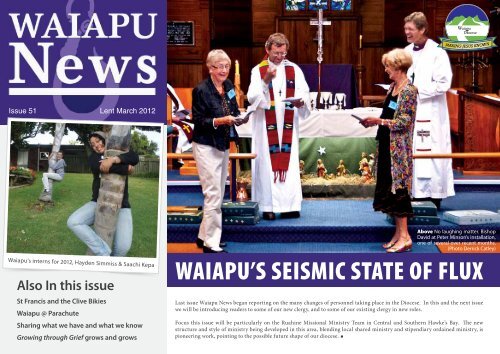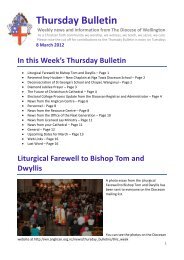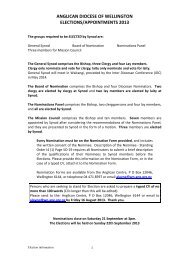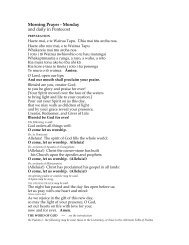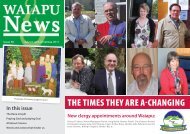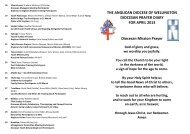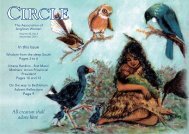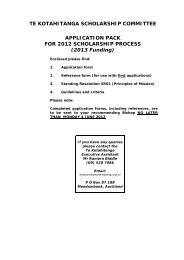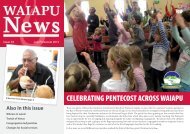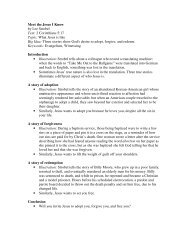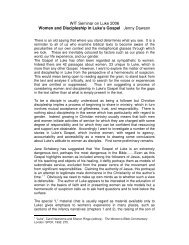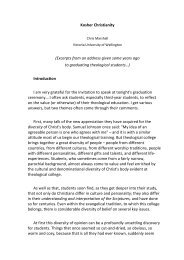You also want an ePaper? Increase the reach of your titles
YUMPU automatically turns print PDFs into web optimized ePapers that Google loves.
From Bishop DavidIam writing on Waitangi Day and atsome stage we will join in celebrationsin Hastings and Clive for this significantday in the life of Aotearoa/New Zealand.Also, this is the day Tracy Cappel Rice was born,wait for it, unbelievably, a half century ago, andher birthday has been celebrated over threeconsecutive days to cover all the hemispherictime differences. And lastly, this is the daythe New York Giants and the New EnglandPatriots join to recreate the North Americanphenomenon that is Super Bowl Forty-Six. Now,I want to be exceedingly clear, I am in no waygiving priority to one of the aforementionedevents over the other (particularly if Tracy castsher gaze over this ink-spill); however, it is thelast event which captures my attention for thisspace.I have watched each and every Super Bowl. Thefirst was in 1967 when the Green Bay Packersplayed the Kansas City Chiefs and the Packerswon with Quarterback Bart Starr solidifying hisstatus as a household name when he was namedMost Valuable Player.And now here in N.Z. as I multi-task writing thisarticle and watching the game all these yearslater, I find myself asking the questions: Whatpercentage of our fellow Kiwis will actuallywatch Super Bowl 46? And I suspect, in starkcontrast, what percentage of Kiwis watched lastyear’s Rugby World Cup?I ask the questions for a reason. Since landingin Aotearoa in the nineties, I have oftenheard comments concerning the perceivedincomprehensible nature of the game called2 Issue 51 <strong>Waiapu</strong> <strong>News</strong>North American Gridiron by those outside theU.S. These comments have ranged from: “Whyis the game filled with so much starting-andstopping?”“Why the conferences after eachplay, what are they talking about anyway?”“What’s with all the gear, big helmets, largeshoulder pads and the like?” “Why do thegames last so #$%@ long?” And finally thecomment: “I don’t understand it, why would Iwatch it.”I want to say here, I absolutely love the game ofrugby. I loved it since the first time I watched agame in the U.K. in the mid-eighties. And, as2011 confirmed, there is no better rugby thanAll Blacks rugby. The thing is, those unfamiliarwith New Zealand’s game would ask similarquestions to those not familiar with gridiron.For instance, “What’s this line-out thing about,isn’t it simply who can be lifted the highest tocatch a ball?” “And ball direction, what a strangeway to move the ball forward by throwing itbackwards, where’s the forward pass?” “Andlet’s not even get into the area of srummaging,a group of guys leaning over and holding oneanother in places which are questionable.” Thepoint is, if unfamiliar with rugby, it would bereally easy to find it more-than-slightly odd andequally easy to say: “I don’t understand it, whywould I watch it?”So here’s the rub, the theological raison d’être,and the segue: if we disregard those people, placesand things we do not readily understand then,please, consider for a moment the opportunitiesof discovery and learning and growing we missin our lives. Moreover, if we entertain andengage in the mantra, “If I don’t understand...”Peter Minson’s Induction, Taupo. (Photo Derrick Catley)then how quickly will our lives be characterizedas maintaining status quo and how ‘set-in-ourways’will we become? Moreover still, if we don’tventure into the unknown due to discomfortwith uncertainty, then how much do we miss ofwhat God is endeavouring to show us about lifeor faith or love or GOD’S SELF.I am not suggesting a belated resolution for<strong>2012</strong>, nor am I trying to convert anyone toAmerican football. I am however endeavouringto encourage one-and-all to move beyond ourcomfort-zone and be with God. And being withGod will always lead us to moments of discoveryand often, let’s face it, to places we would rathernot venture. I pray <strong>2012</strong> will be a time of suchdiscovery for us all.So Happy Waitangi Day, <strong>Waiapu</strong>, HappyBirthday Tracy Cappel Rice, you’re lookingamazing, not a day over thirty-something andit is now finished, the New York Giants wonSuper Bowl 46.Arohanui+ David, Bishop of <strong>Waiapu</strong>.
Bishop Murray Mills, supported bybrother Robert, in <strong>Waiapu</strong> Cathedralcelebrating 50 years as a priest.The altar fire at St Michael and All AngelsPorangahau miraculously failed to spreadthrough the church.St Francis Whanau Aroha Early Childhood andFamily Support Centre Rotorua achieved theHeart Foundation Healthy Heart Award.Events around <strong>Waiapu</strong>Chris Parkes (centre left) Chaplain atHodgson House since 1997, at her retirement.Ruth Dewdney’s ordination in <strong>February</strong>.<strong>Waiapu</strong> delegates at the three tikangayouth synod in Auckland in <strong>February</strong>.Issue 51 <strong>Waiapu</strong> <strong>News</strong>3
Ruahine Missional MinistryThe beginning - On the road togetherJo CrosseThe Ruahine Ranges stretch thelength of the newly formed regionalmissional ministry, and their ruggedprofile creates a stunning backdropwhich is familiar to those who live and workin the area.On the day of our hikoi there was heavy cloudand rain so these beautiful mountains werenowhere to be seen, as we set off to journeytogether by bus.The itinerary included visits to seven parishesover eight hours covering more than 250km,and as Bishop David, the newly installedRuahine Regional team and 23 supporters setoff from Waipawa there was great anticipation.Ruahine Hikoi TakapauRuahine Hikoi Woodville presentation ofsymbols - tree seedlings & walking staffsRuahine Hikoi Dannevirke congregationIn every parish we were greeted by the locals,we shared liturgy, the team were welcomedand blessed and symbolic gifts were presented.As Tim, Craig and Heather were presentedwith gifts ranging from wine to tree seedlings,from gumboots to walking staffs, and as all ofus enjoyed the warm welcome and wonderfulfood of our various hosts, the character of theregion emerged.Despite the diversity of our geography and thephysical distances between us, hopes are highfor this new beginning. There is a desire tobuild on our existing relationships, hospitalityis a high priority, and in every place there isa sense of urgency about going forward andfinding new ways to be church wherever weare. To begin by journeying together wasinspiring, and we look forward to the ongoingpilgrimage of the coming weeks and months.Ruahine Hikoi WeberRuahine missional ministry potentialPints of ViewRuahine missional ministry gIfts fromparishes4 Issue 51 <strong>Waiapu</strong> <strong>News</strong>
St Francisand the Bikies“How did old folk like us get involved insomething like this?” Shirley King describes howa small parish connects with its community.What does a small co-operating parish, witha Parish Council of 9 members whose averageage is 63 years, have in common with a BMXbike track at Clive?Over the years parish members have oftenasked themselves: “How can we reach out to theyoung people in our community in ways thatwould engage them?”It started by holding craft mornings duringschool holidays. This attracted good numbersof both boys and girls and catered well for thosechildren with a ‘creative’ bent. But what aboutthose children who liked to be more active andphysical? At a meeting early in 2011, a longstandingparish councillor suggested we holda BMX competition and he would donate $50towards prizes. While all on parish councilwere well past riding a BMX bike, all were keento give it a go.Clive has a very small existing track beside theriver that could hardly be called a BMX trackbut is used quite regularly. To attract moreyoung people, it needed some work done on it –but where to start?An “on site” meeting was held between MarkSeek (youth worker at St Columbus, Taradalewho has been involved in building BMXfacilities in Golden Bay) and the Parish Councilchairperson. Mark was very enthusiasticabout the idea of developing the track furtherand put forward several suggestions. Hebelieves the way to reach young people thesedays is through food and giving them yourtime! Giving time as a parish to this venturewas a good start. It would show young peoplethat others are interested in them and keen toprovide outdoor challenges that they can enjoywith their friends.So, what did we do? Over the next few months,we consulted with the Chairperson of the CliveCommunity Council, Tony Loversuch, whowas very enthusiastic about any help we couldgive to the young people of Clive. Tony advisedthat the Regional Council was preparing plansto enhance facilities along the Clive River bankand could be useful to contact.Next we decided to hold a fun bikemorning for all ages on the existing trackin July 2011. This was a way of gettingyoung people together in the holidays.The Bikie kids.Unfortunately, the weather was against us,and it was completely washed out by rain!Not to be deterred, we scheduled anotherfun day for the October school holidayscomplete with competitions, prizes, asausage sizzle, time trials etc. and this wasattended by a good size group of 8 – 12 yearolds. 3 of the parish members assistingwere over 70 and the comment was made,“How did old folk like us get involved insomething like this?” However, all agreedit was an enjoyable and successful event,both for organisers and participants.Where to from here? We have let the youngpeople of Clive know we are interested in them,and we have trialled a succesful and fun eventon the existing BMX track; how can we keepthis project alive and moving ahead?In November at our Missional mappingplanning meeting, Parish Council agreed toinvestigate taking on the upgrade and upkeep ofthe BMX track as a parish project for <strong>2012</strong>. TheRegional Council, who have prepared tentativeplans to upgrade the track, are happy to assistwith this but are keen that the local communitytake responsibility for the care and upkeep.We now need to organise some fundraisingto progress this project and consult with theyoung people in Clive to get their views on theproposed changes to the existing track.So, if you drive through Clive, keep an eye outfor developments and happenings along theriver bank. You may well see some grey hairpeeping from under those safety helmets. Whoknows what new pursuits will be available foryoung and old in Clive!Issue 51 <strong>Waiapu</strong> <strong>News</strong>7
Sharing our strengths<strong>Waiapu</strong> and its Tikanga Maori partners are exploring new waysof working together. Noel Hendery reports on the early steps.<strong>Waiapu</strong> began as a missionarydiocese. The first Synods wereconducted in te reo Māori.Never perfectly embodied,<strong>Waiapu</strong> nevertheless has a strong biculturalheritage that still helps define the diocese in the21st century three tikanga Anglican Church.Late last year, Standing Committee metrepresentatives of Te Manawa O Te Wheke andTairawhiti, the two Hui Amorangi that cover thearea covered by <strong>Waiapu</strong> Diocese.The meeting explored opportunities for resourcesharing which could flow in both directions.Specific issues canvassed included:• Experienced priests assisting the preparationof new priests.• Interregnum appointments; for example, aMaori priest caring for a Pakeha parish untila new vicar had been appointed• Cross Tikanga appointments, as hashappened with Rev’d Stephen Donald in theEast Coast Parish• Working together on church service planning.This would result in the encouragement of agreater use of both languages in worship• Better utilization of churches• Sharing of expertise• Joint clergy conferences and social service hui• Cultural training and education• Marae experiences• Possible appointment of hui amorangirepresentatives to Diocesan boardsCliff Houston, Diocesan Registrar, describedthe meeting as “one of the most positivemeetings I have ever attended. There wasa willingness to share and consider eachother’s needs and to ensure that serviceswithin geographical area of concern could bedelivered in the best possible way.“Resource sharing is a two way trade. The Diocesehas a strong infrastructure; the two Amorangihave a cultural richness that can be shared withthe Diocese. We can offer physical structures.They can offer insights into their structures.”Rev’d Jack Papuni of Tairawhiti commented:“I have to agree with Cliff, it was a verypositive discussion.“For me, the two most important principles weneed to gain before we can be truly bi-culturalor share resources with confidence betweendiocese/hui amorangi are respect and havinggood relationships with each other, whichin turn build trust. This begins at parish orregional level.“What happens in Eastland is a goodexample of this: Mihaia and St Andrew’scongregations attend each other’s worshipservices alternatively. Rev Stephen Donaldlooks after Tokomaru Bay services. Pastoralministry is shared by the team. We also havethe opportunity to attend regional executivemeetings, social gatherings and clergy kura.Rev Mona Scott continues to assist withworship services and Te Hapara and WhanauAroha Family Centre. If this kind of regionalministry can happen throughout the dioceses/hui amorangi then we will really know Jesus.“The pilgrimages were great and important forus all. Could we resurrect these?”The next stepsThe paper generated following the day’sdiscussion has been circulated to the threegroups. Discussions have continued between thegroups about implementation of the proposals.One relevant decision has been for <strong>Waiapu</strong>and Tairawhiti clergy to meet for a joint clergyconference in Gisborne this year.It is hoped that before the next scheduledmeeting in November this year that some furtherconcrete results will be achieved.Cliff Houston is optimistic of the outcome: “Onething that came out strongly was the history of<strong>Waiapu</strong>. The links and the relationships are stillvery strong and forged in the bonds of history.”Clergy Comings and GoingsRevd Arthur Bruce, previously Missioner ofPapamoa Mission was installed as the Vicar ofHiona/St Stephen’s Anglican Church, Opotikion the 1st <strong>February</strong>.be installed as Missioner Priest to theRiverslea/Mahora region at a service tobe held at St Peter’s, Riverslea on Sunday25th March at 10am.Revd Graeme Pilgrim, Vicar of St Matthew’sParish, Hastings has announced hisretirement. His last service as Vicar will takeplace on Sunday 22nd April.Revd John Hebenton, previously the AnglicanYouth Network Facilitator for TikangaPakeha, was installed as the Vicar of StGeorge’s Anglican Church, Gate Pa, on the20th <strong>February</strong>.Revd Tim Barker, previously from StFrancis Co-operating Church, Clive is toRevd Trevor Harrison, previous Vicar ofSt Augustine’s, Napier, departed <strong>Waiapu</strong>in January and was installed as RuralDean of South Taranaki and Archdeaconof Waitotara in the Taranaki and WaikatoDiocese on the 22nd January. RevdDorothy Brooker is currently part-timePriest-in Charge.Revd Stephen Hayes, Vicar-elect of AllSaints, Taradale, is currently waiting on visaconfirmation to allow him, his wife anddaughter to enter New Zealand from theUnited Kingdom. It is anticipated Stephenwill arrive in Napier in mid-June, and his wifeand daughter will follow a month later. Hisinstallation date is yet to be decided.Arthur Bruce awaiting the karanga at Opotikiinstallation.8 Issue 51 <strong>Waiapu</strong> <strong>News</strong>
Howard PilgrimFrom the Diocesan TheologianWaiting on God“The world is too much with us; late and soon,Getting and spending, we lay waste our powers”These opening lines from one of Wordsworth’ssonnets linger in the back of my mind as Lentapproaches, expressing a sense of how much Iam captured by my everyday world, “gettingand spending”. I’m surviving, to be sure, butwhat is happening to my “powers”, my fullestspiritual potential?Wordsworth’s sonnet calls for a return to apre-industrial, semi-pagan life lived in closerharmony with nature. My Christian faithagrees with his identification of the spiritualproblem, but propels me towards an entirelydifferent solution. The deadening effect of life’severyday demands can only be overcome byconstantly renewing my connection with theliving God who creates all of this world andmy life in it.St Paul thought of this in transformative terms.Our everyday life in the world, dominated andformed by its concerns and necessities, is onepart of our essential being which he calls “theflesh”. Left to itself, it will die, but that is notGod’s intention. We have another side to ourhuman potential, called “the spirit”, whichfeeds on God’s presence offered to us in Christ.I can chose to be nourished by that presence,so that my human existence is transformedby his eternal life, or I can shuffle through mysame-old routine until it’s over and I’m dead.All the great saints in our Judeo-Christiantradition have shown their awareness of thisstark choice. St Paul knew that if he set hismind on the life of the spirit, it would bringlife and peace, even in the face of suffering. Heexpressed this as a determination to share inChrist’s death so that he could also experiencehis resurrection. Spirituality was not anoptional add-on to ordinary life, but rather anall-or-nothing drive to connect with the livingcreative force at the world’s heart.Centuries before, Isaiah captured the same vision:“Even youths will faint and be weary, and theyoung will fall exhausted;but those who wait for the LORD shall renewtheir strength,they shall mount up with wings like eagles, theyshall run and not be weary, they shall walk andnot faint.”At the start of Lent, we take on ashes signifying ourmortality, and hear the words, “You are dust, andto dust you shall return. Repent, and believe thegospel.” Then we begin our season of meditatingon the mystery of death and resurrection that cantransform our life in this world.Historic Cross returned to <strong>Waiapu</strong>Historic cross returned.Noel Hendery.In late January Lady Beverly Reeves presentedBishop Murray Mills (as the diocesan archivist)with a pectoral cross that has strong historic linkswith <strong>Waiapu</strong>.The cross originally belonged to Bishop HerbertWilliams, the sixth Bishop of <strong>Waiapu</strong>. It waspresented to him by the clergy of <strong>Waiapu</strong> at hisordination as Bishop in 1930 (at the age of 70).Bishop Williams’ son, Rev’d Nigel Williams, wasvicar of St Thomas’, Newtown, Wellington, whenSir Paul lived in Newtown as a young man. Nigelpresented the cross to Sir Paul at the time of hisordination as Bishop of <strong>Waiapu</strong>.Lady Reeves wished to fulfil Sir Paul’s request thatthe taonga be returned home to <strong>Waiapu</strong>. Thepresentation was made in St John’s Cathedral’sMaori Chapel in a simple service.She said that although Bishop Reeves had otherpectoral crosses, he wore this particular crosson most occasions throughout his ministry asbishop and archbishop.On the front of the cross is a motto in Welsh thatthe Williams family believed belonged to theirforebears. In English it means “What God wills,will be.”The cross will remain in the Cathedral until it isdecided how it will be used.Bishop Herbert William Williams was Bishopof <strong>Waiapu</strong> from1930 until 1937 and was adistinguished Māori scholar. He compiled a newand greatly extended edition of the WilliamsMaori-English dictionary and produced anexcellent revision of the Maori language Bible.Born at Waerenga-a-hika, Gisborne, andeducated at Christ’s College, Christchurch, theUniversity of New Zealand and Jesus College,Cambridge, Herbert Williams was ordainedin 1886 and began his ordained ministry as acurate at West Wratting. After this he was Vice-Principal, then Principal, of the Māori TheologicalCollege Te Rau Kahikatea in 1889 and laterSuperintendent of the Missionary East CoastDistrict. From 1907 to 1930 he was Archdeaconof <strong>Waiapu</strong>. In that year Herbert followed in thefootsteps of his grandfather (William Williams,the first Bishop of <strong>Waiapu</strong>) and father (LeonardWilliams, the third bishop) as Bishop of <strong>Waiapu</strong>.Issue 51 <strong>Waiapu</strong> <strong>News</strong>9
Seasons“I liked it that I could share about my life”TMCarol Goldie-Anderson, Seasons ProgrammeNational Coordinator, <strong>Waiapu</strong> Anglican SocialServices, updates a major <strong>Waiapu</strong>-originatedprogramme.The Seasons programme is all about stories.“I liked it that I could share about my life”, aten year old boy tells us. Children come to theprogramme because of grief and loss in theirlives, to find a place to tell their story, to be heardand supported. We know how important this iswhen a child sums up the Seasons experiencewith: “You listened to me”Inside each one of us is a story which is very special.Everything we go through in life adds to that story.Everyone has a story belonging only to themselves,although some peoples’ stories meet up (Seasons)Liss Lloyd, from St John’s Otumoetai, is notonly one of those volunteers, but the longestserving Companion (facilitator) in the country.In December Liss was awarded a Trust BoardExcellence Award for Service, honouring hersixteen years of being a Companion, listening tothe stories of children.Liss tells us she was drawn to being a Companionthrough her own grief.“After my baby died and later my mother too, itwas realizing how difficult it is to cope with losseven as an adult. We are told to get on with lifebut it’s really hard when you have a huge losspain, so how do these kids cope? I keep comingback to Seasons because I see how much childrenget out of it. It gives them skills and strength, selfworth again.”Dawn Picken, Fiona (8) and Finley (6), at an event hosted by Growing Through Grief Tauranga,“Devonshire Tea with Judy Bailey”.Seasons itself has become part of the story of manyof us, and our stories meet up from all around thecountry. Within <strong>Waiapu</strong> the Seasons programmeis provided by our 10 Growing Through Griefservices, and the programme is available in fourother dioceses too, also under the auspices of ourSocial Services Trust Board. In 2011 we reached atotal of 22 parish based services: those in <strong>Waiapu</strong>,and the rest in centres from Wellsford to Dunedin,New Plymouth to Carterton.Nationwide, over 1100 children came to Seasonsgroups last year, and 27 Coordinators workedwith committees and more than 200 volunteers.Every one has their story.“Seasons has become a big part of my own story,”Liss says. “There’s always another child out there,it’s something I can still offer. It’s an honour forus as Companions, we are entrusted with thepain of the children, there’s a humbling aspectabout it.”Like Liss, the families who come to Seasons,have the story which brings them to us, and thenSeasons becomes a part of their story too.Following the death of her husband, and ajourney from America, Dawn Picken and herchildren Fiona and Finley, reached St Mary’s,Mount Maunganui and found the Seasonsprogramme. After the first session, Finley said, “Ilearned a new word. It’s CON-FID-EN-SHA-AL-IT-EE. Fiona said, “It means you don’t tell storiesabout other people.” (This one is reproducedwith permission!) How important is that? It iskey. Our 2010 research into the impact of theSeasons programme showed that young peoplegreatly valued belonging to a group where theycould express themselves openly and honestlyand “with a high sense of emotional safety.”The research itself is another story. The study,undertaken by Joy Tomoana and supervisedby Dr Peter Bray, has now been published asan article entitled The Impact of a Peer SupportProgramme for Children who are ExperiencingLoss: A New Zealand Perspective on the USwebsite of The National Institute for Trauma andLoss in Children. It is exciting to have our localwork recognized in this international forum, andwe await what may flow from this.2011 brought other developments too. Wehave a new trainer, Ee Li Hong, Coordinatorfrom Whakatane, who is a wonderful additionto the training team. There was continuingContinued on page 1110 Issue 51 <strong>Waiapu</strong> <strong>News</strong>
Life With BrianShedding Some StuffThis is going to be a moving year forme. I haven’t had one of those for awhile, in fact the nine year periodI’ve spent in Havelock North is thelongest I’ve stayed in one place in my entire life!Moving regularly has its downsides, but onedefinite plus is the opportunity to go throughall your belongings and shed some stuff thatyou don’t really need to carry from one placeto the next.Of course there are some things you just can’tbring yourself to shed. For me that’s always beenmy comic collection. For decades now I havebeen carrying boxes of carefully packed comicsaround, each stored in its own plastic bag, andto be honest I’m not sure I can remember thelast time I actually took them out of the boxes.For me those comics are a reminder of myyouth, but I am wondering whether this mightbe the time to let them go.I suspect we all struggle to let go of things thatremind us of a different time, speaking of which– did you know <strong>2012</strong> is the 350th anniversary ofthe 1662 Book of Common Prayer? Yes, for threeand a half centuries clergy have been solemnlyintoning the usually less than cheerful rites of theBCP and reminding us all that Jesus really was“the propitiation for our sins”. While Cramnerwasn’t the author of the 1662 Prayer Book (whichwas, in true Anglican fashion, shaped by acommittee) it was his work on the 1549 and 1552prayer books that laid the groundwork for whatwas to come, and I can’t help but think he wouldbe horrified to know we were still using the samewords and phrases used in the 16th and 17thcenturies three hundred plus years later.Two key principles shaped Thomas Cranmer’sapproach to liturgy: First, it had to be in thelanguage of the day, and second it had to carrythe burden of lex orandi, lex credendi – what wepray is what we believe.There is no doubt that the 1662 Book ofCommon Prayer and the relatively minorrevisions of the 1928 version contain somebeautiful words and images. The old collectsand canticles carry a poetic cadence thatmany more modern equivalents lack, andto those who love them they still speak, butdo they speak to others? Listening to an oldCommunion service or Evensong, would astranger to the BCP recognise within it thelanguage of his or her day? And as we say theold prayers, with their constant confessionsand begging for mercy from a God whose“wrath and indignation against us” we haveprovoked, do we believe it? Is this the God wehave faith in and worship?I wonder if this is the time to think aboutshedding some more stuff? One possibilityI’m considering with my comics is choosingone or two and having them framed. Then Ican display them without the need for lots ofboxes cluttering the place up. Perhaps after 350years we could do the same with the BCP? Wecan acknowledge its beauty and meaning byensuring our cathedrals offer well crafted andprofessionally delivered services from it onceor twice a year, more as concert pieces thanacts of worship, but on a weekly, fortnightly ormonthly basis perhaps we can do as Cranmerdid, just three years after his first prayer bookwas published, and admit that its time is doneand prepare to move on, leaving behind thatwhich we don’t want to carry.outreach, taking the Seasons programme toneighbouring, sometimes remote, areas: toMurupara, Mangakino, Manaia, and Wellsford.There is also a new service finding its feet inthe Parish of Pohangina, and other enquiriescoming in. In Auckland, the six parish-basedSeasons programmes are now collectivelyunder the banner of Grief and Loss SupportServices, Auckland, with Judith Derbyshireappointed as Fieldworker.Our stories will continue to unfold andinterweave through <strong>2012</strong>. From Judy Bailey,so graciously our National Patron, to thosewho fund and support us, to our volunteerCompanions, our committee members andhome parishes, to schools that host us, ourCoordinators, the families and children.Seasons can be a remarkable and healing partof the story of any and all of us“Seasons helped my kids and I honour andunderstand our new family,” Dawn says.” Wehave each other. We have people able andwilling to help. We’re part of a larger worldfilled with kindness, compassion and peoplelike those at Seasons with big ears and evenbigger hearts.”Thank you to all who are part of the Seasonsstory and welcome to all who would like to be –it could be for you as much fun as one five yearold discovered – “I liked Seasons two trillionand 66 ! We got to use stickers!”Liss Lloyd was presented with her ExcellenceAward for Service by Judy Bailey.Issue 51 <strong>Waiapu</strong> <strong>News</strong>11
Jo CrosseView from the CafeBeyond Easter EggsIt’s January and there are already Hot CrossBuns and Easter Eggs in the supermarket.A local shopper stands beside me as weboth shake our heads and wonder aloudat the speed with which the marketing switchesfrom Christmas to Easter!For the church, this presents us with a realchallenge as we work our way towards AshWednesday, and then spend the weeks of Lentpreparing ourselves for the events of HolyWeek and for Easter celebrations. It’s especiallychallenging to find ways of helping childrento experience the sense of waiting and theanticipation of a climatic, life changing eventwhen the world around us looks as if Easter isNOW. Why wait?We need to help children to understand this timeof waiting, to find ways of encouraging them andtheir families to join in the waiting and to havean opportunity to deepen their faith and to movecloser to God. Rather than focussing on Lent in anegative way as “giving up” or “going without” wecan help by talking about Lent as an opportunityto make more room in our lives for us to be withGod and to focus on our faith. All of us needthat time and all of us need to create that spaceif we take our faith seriously, but sometimes westruggle to figure out how we go about it. Lastyear our family had an outline drawing of anEaster lily with numbered spaces for each of thedays in Lent; each day we added a sticker so itwas simply a way of keeping track of the days andmarking the time of waiting. This year I wentlooking for something which would encouragesome deeper engagement and found two ideaswhich appealed to me, so I thought I would sharethem here. There are many online resources andsuggestions but these two come fromwww.ehow.com/info_8299343_lenten-craftschildren.htmlChildren can make a paper chain to count thedays until Easter. Cut 40 two-inch wide stripsof purple paper. Cut one strip of white paper torepresent Easter, and six strips of another color torepresent Sundays. Have children draw or write oneach strip of paper something that they will do toshare their faith (for example visiting a local resthome, helping with housework, inviting a friendto church, or doing some baking for someone).You could also add a short prayer each day or asentence of scripture. They can then staple or gluethe strips of paper together to form a chain, withevery seventh strip a Sunday strip and the Easterstrip at the end. Hang the chain and let childrenremove a strip each day until Easter and do whatis written on the chain link.Help your child draw a large tree shape with barebranches on a piece of poster board. Cut 40 leafshapes out of construction paper. Help your childwrite a different thing on each leaf that they cando during Lent to be of service or to sacrifice. Forexample, they could write that they will help aneighbour with yard work, donate some toys toa charity or make their bed without being asked.Hang the poster on your child’s wall and place theleaves nearby. Every day that they complete whatthey wrote on a leaf, they can glue it onto their tree.And most importantly, enjoy this opportunity torefocus and reflect – if our children see that thisis important to us, then they will come to value itfor themselves.<strong>Waiapu</strong> <strong>News</strong> schedule changed to suit parishesIf <strong>Waiapu</strong> <strong>News</strong> is delivered to people’s homeswith the parish magazine, then more peopleget to read <strong>Waiapu</strong> <strong>News</strong>.With this thought in mind, we have decidedto change the schedule for <strong>Waiapu</strong> <strong>News</strong> fromthe next issue. Until now, it has normally beendelivered to parishes a few days before thefirst Sunday of the month.As from next issue, we will be delivering it toparishes a few days before the last Sundayof the month. For example, the May issuewill arrive mid week before Sunday 29April. This will allow those parishes thatsend out parish magazines to includecopies of <strong>Waiapu</strong> <strong>News</strong> each time they arepublished.The rest of this year’s issues will bepublished just prior to May, July,September, December.12 Issue 51 <strong>Waiapu</strong> <strong>News</strong>
Leo Te KiraBoundary RiderNoel Hendery talks to a priest whose newministry is outside parish boundaries.On a Thursday evening my phone rang.It was one of the dedicated members ofMahora Parish who visit Colwyn Houserest home: “We’ve just met the newchaplain at Colwyn House. He’s such a nice youngman; and it’s so good that the Anglican Church hasfinally got around to providing a chaplain.”Leo Te Kira, that nice young man, has a knackof being the right person in the right place at theright time.They were so connected to what was going onaround them in the wider community. That’swhat I enjoyed more than anything else – theywere street wise.”Then in 2010 the plans to restructure ministryin rural Hawke’s Bay began to take shape. Thisinvolved disestablishing the Vicar positions atDannevirke and Waipukurau, to be replacedby a team of three regional missioners. For Leo,sensitive to the feelings of his parishioners, it was along year. “It was about the safety of having a vicarthere since 1877 – and we were enjoying ourselves!But by November they were ready for the change.”to pay. How do families experience ownership ifyou waive the fees?”As a response to this question Leo discussedwhakaaro, “which is Māori for contributingof time and other resources as a result of yourdeep thinking about the matter. Both thestruggle you wrestle with in order to find anappropriate way to contribute and the eventualcontribution in kind as a result of that wrestleare involved in whakaaro.”What does Leo see as his future role? “Being aspringboard for discussions on Māori thinkingand Māori perspective. And, equally important,impressing on the centres that the best type ofMāori partnership is getting in touch with localMāori rather than having a <strong>Waiapu</strong> AnglicanSocial Service person giving the advice. I canoffer nationwide generic understandings of Maoriprotocol or tikanga, but Māori culture only comesalive when you get to know the local variationsof these tikanga; location specific variances onthose protocols known as ‘ kawa’. The marae akilometre down the road may have a differentkawa even from the one across the road.”Although Leo’s role as aged care chaplain is thesmaller one, it is still very important to him.Colwyn House has two wings, each with a capacityfor 22 elderly people. House-Side of Colwyn,renamed in January the Matai Wing, is for thosewith high psycho-geriatric needs, while the KowhaiWing is for those with high psycho-geriatric needscompounded by behavioural unpredictability.“It’s going to be an incredible challenge in that I’vealready discovered how hard it is working withpeople who can barely make it to their third sentence.It’s a challenge; I’m looking forward to it; and it’s areminder to me that faith and spirituality and theWord of God need to be available to anybody, nomatter what their level of comprehension.”“It reminds me that the Church and the Dioceseserve people, living out the Gospel in so manyways, not just on Sunday in Church. Churchcan be running an exciting child care centreor a vibrant youth centre. Sometimes it evencan involve being part of a rest home for thosewho because of the severity of their age-relatedillness are deprived of any opportunity to knowexcitement and vibrancy.”Leo came to <strong>Waiapu</strong> from Wellington, wherehe had been a priest for 12 years with Te HuiAmorangi O Te Upoko O Te Ika, the Maori regioncovering the area of the Wellington Diocese plusTaranaki. He had begun as curate in the Rimutaka(Hutt Valley) Maori Parish, followed by 10 yearsas priest in charge of the Poneke (Wellington)Maori Parish.Bishop John Bluck was interested in encouragingMaori clergy to come to <strong>Waiapu</strong>. Jack Papuni,Regional Ministry Convenor, contacted Leo theday before his fortieth birthday to test the waters.At the time Waipukurau was vacant.Following a call from Bishop John, Leo wentthrough the selection process, and in 2006 begansix years as Vicar of Waipukurau. How was it?“Loved it. I didn’t know if I could go from innercity to semi rural, but the people were amazing.Leo could have put his name forward for oneof the new positions, but after studying the jobdescriptions, he decided that “they weren’t me.”Bishop David offered Leo two part time positions:Maori Advisor to Anglican Care and part timechaplain to Colwyn House.He began in December. His work will includeworking with Anglican Care’s Māori policy andexploring where it can be developed further;being available to management and the fortyservices around the diocese, and working withKaren Fagan to see if there is scope for anothercommunity service in Napier / Hastings.First up, Leo had visited Te Hapara WhanauAroha Centre in Gisborne. “Their ideas ofpartnership with Maori are going along well.However, we did have a good discussion aboutfamilies who need child care but cannot affordLeo with Colwyn House Clinical Co-ordinator Jodi Parkes Clinical Co-ordinator.Issue 50 <strong>Waiapu</strong> <strong>News</strong>13
The Anglican Night Prayer on Saturday andSunday Eucharist were well attended and createda space for quiet reflection and worship.The traditional barbeque ‘pancake breakfast’ wascooked up on Monday morning by ArchbishopDavid, Alex Czerwonka and helpers to sustain thetroops before packing up and heading home after aweekend of fun, fellowship, worship and buildingof friendships amongst the Anglican family.Jocelyn Czerwonka.Parachute was once again a blast, just thetonic I needed to feel inspired, enthusedand ready to start the year. Our youthinterns both past and present, and somewho tagged along, were quickly at work settingup, pitching tents, running errands and generallyhelping out. From Dunedin, Alexandra, Nelson,Wellington, <strong>Waiapu</strong>, Auckland and Waikatopeople gathered to form the Anglicans@Parachute Super group.Our base camp was a great gathering place.Many popped in just to visit and enjoy thefellowship in our canvas lounge set up withcouches, good food, cups of tea and lots offriendly and happy, although somewhat sleepdeprived, people.There was something for everyone. For someof the not so young we enjoyed things like the‘Over Forties Tea Party’, Randy Stonehill, bandslike Alaska, Avalanche City and Casting Crowns.Even our Bishop (after much protesting andsquirming) had to admit, after being draggedalong to the band Alaska, that their ‘Indie folk’music was very good.This was the feedback from one of the manygroups who joined us: “It was really nice tohave that support & peace of mind knowing thatbreakfast & dinner was taken care of! It was thefirst time we’d taken a group to any camp so thankyou again for making our experience so mucheasier and enjoyable. We all had a great time andthe feedback has been amazing :)”And this is what Hayden, Saachi, Brendon andSimon had to say:Helping set up camp on Thursday was veryexciting. Got the blood amping for the ParachuteFestival. No sleep! Too excited. Friday morningrained but it was very exciting anticipatingeveryone’s arrival. There were good bands, anawesome village and loads of really awesomepeople. We had people dressed as a nun (Simon)and for some dying their hair bright orange(Brendon) was their idea of fun.Stefan Keogan (Rotorua) Simon Holmes-Dawson (HB) and Brendon Bryon-Kay(Eastland) attending the Eucharistsee. I reckon they should extend Parachute to awhole week!!Monday was packing up day. Everyone wasextremely tired but pack up was very clean andsuccessful. Quite sad to be leaving the festival butall the same great to be home!Parachute is a weekend for the whole family, foranyone who wants to meet new people and havesome fun doing it this is the place to be. The SuperGroup is a great way to be a part of the action.The village was an exciting little township in themiddle of the festival. With my money burningin my pocket I couldn’t help but buy many greatthings. Parachute Festival was indeed a veryamazing experience, watching bands such as “TheAlmost’, “Young Lyre”, ”The Chariot” and “SavingGrace”. (Saachi)Anglican Supergroup. Photo’s by Chris ParkinFor me (Hayden), this was my 4th year atParachute. This year I helped with setting up,cooking, getting gear, food and people from thegate at the top of the hill (a long way away!). Imanaged to have a good amount of sleep (wisdomfrom the past) and see all the bands I wanted toBBQ mafia. Quiz: Who is the toughie on the right?14 Issue 51 <strong>Waiapu</strong> <strong>News</strong>
Oenone WoodhamsFrom the Ministry EducatorIcannot believe that the New Year haswhizzed around again, and that I’mbeginning my third year as MinistryEducator. Happy New Year to you all!Even though in my local supermarket at the timeof writing (early <strong>February</strong>) the hot cross buns arealready on display. However, I do hope you havehad a chance to slow down, rest, relax and refreshyour soul.We have undergone significant changes as aDiocese in the past 12 months, with more changesto come. But out of these unsettled periods comesgrowth, I firmly believe. Bishop David last yearasked us to preach one sermon, that of mission.Of course every sermon is really about mission ifyou come down to the nitty gritty of it. Becauseeven those passages of the Bible that may seemto be solely about personal issues, actually haverelevance to each individual’s community, and itis through the relationships built in communitythat the mission of the church is released.Alan Roxburgh, the keynote speaker at last year’sclergy conference and laypersons day, has beenin touch. A group of clergy will be specificallyworking with Alan on how we here in <strong>Waiapu</strong> canbe truly, deeply missional, in a way that becomesingrained in the fabric of our communities. Thisis an exciting project, and I will keep you postedon progress. Also in other news, this year we arejoining with Tairawhiti in a tikanga rua clergyconference in Gisborne. Deepening our bondswith tikanga Māori can only be beneficial to ourmissional church.And so to the library. A whole heap of new bookshas just been catalogued by those busy beesat the Kinder Library who don’t seem to takeholidays. (The library budget has been well andtruly spent.) I have several new resources forsmall groups, and a great audiovisual selection– CDs and DVDs available for borrowing. ButI have to say that some people got in reallyearly and borrowed Lent resources last year!So it does pay to be quick.I’m also starting my rounds again. I’m veryhappy to visit your parish, bring some books, talkabout study options, take a workshop, preach asermon or anything else that may be useful.If you want to discuss anything educationalor formational or if you are keen to exploreGod’s call on your life to ministry, I am easilycontactable, especially by email.oenone@waiapu.comUntil next time... Shalom,Oenone Woodhams.A GiftCushla Randle learns from the spiritualty of hergrandchildren.We arrived early at the Cathedral to get readyfor the baptism. Zach and Izzy had been theretwo or three times before. They entered happily.Zach wandered round quietly looking intentlyat the stained glass windows and talking tosome of the parishioners. Izzy’s face lit up asshe saw a small table and chairs with felt pensand pictures to colour. “Come on, Grandma,”she said. I sat gingerly down on one of the smallchairs. We set to work.During the baptism Zach stood quietly at theside of the font next to the Dean. She announcedthat Zach would pour the water into the font.Which he did. Carefully and concentratedly.Holding Izzy, I saw her eyes watching andcalculating. So it did not surprise me, whenall the gifts were carried to the altar beforecommuion, to see her marching confidently upthe aisle, beside Zach and the Sunday Schoolteacher, carrying a small wooden box. However,a major step for Izzy, who does not often wantto play a public role. They then joined us forcommunion, quietly and at ease.My whole feeling was that they were ‘at home’with the place and the rituals, using that term inits best possible sense.I thought how Zach, as a very small child, hadgone with me both to church and to pre-schoolmusic at the Papamoa Mission. “We are goingto Church” he would say to anyone who calledmusic something else. To him it was all one andhe loved it. And he knows what means most.Although he enjoys any activity used to illustratethe gospel, it is the time of preparation forcommunion, and the communion itself, thatmatters. “This is the best bit,” he whispered to me.And the first time I remember it capturingIzzy was Arthur Bruce’s service on the lostsheep. The next family service, Izzy was abouttwo. She ushered us firmly into the front row.Arthur started on a totally different theme.He asked a question. “Sheep” Izzy answeredfirmly. He rephrased it. “Sheep” came again.Izzy had grasped firmly that the sheep andtheir shepherd were at the heart of the matter.And that was it.And it seems to me that this ease and comfortand certainty is a great gift.Zach Tkaczuk pours the water for his cousinSophie’s baptism.Issue 50 <strong>Waiapu</strong> <strong>News</strong>15
Introducing Our <strong>2012</strong><strong>Waiapu</strong> Youth InternsJocelyn Czerwonka.Now into our 3rd year of hostingYear Long Internships with youngpeople we are looking at ways totailor-make the internships tobetter suit the gifts and abilities of the youngpeople who apply. Doing this helps to keepus true to our goal: “Helping young peoplediscover God’s call for their lives in an Anglicancontext in the Diocese of <strong>Waiapu</strong>”.Let me introduce you to two young peoplecommissioned as <strong>Waiapu</strong> Youth Interns at theCathedral on <strong>February</strong> 12th.God. I hope to improve on my music for worshipand to finish my papers. I also want to growwith confidence in myself.”Saachi loves music, song writing and art. Shejoined the Gisborne youth group last year andwas soon asked to sing and play her guitar atHoly Trinity Gisborne. Saachi’s first placementwill be at <strong>Waiapu</strong> Cathedral working alongsideDean Helen and helping to support their fledgingyouth group. To compliment her musical talentSaachi will be doing the EDITS Music andWorship paper tutored by Colin Gibson.Hayden SimmissOur <strong>2012</strong> <strong>Waiapu</strong> Youth Interns, Saachi Kepa and Hayden Simmiss.Saachi KepaSaachi is from Eastland. Her musical talent wasspotted by one of last year’s interns, Seini Tawa.Saachi is 18 and has just completed her secondaryschooling at Campion College, Gisborne. Priorto this she attended Sacred Heart College inNapier as a boarder.About the internship Saachi says she is lookingforward to:“Meeting new people, learning and experiencingnew things about myself and about my faith inMany of you will know or remember Hayden asone of our Summer Interns in 2009. Hayden isfrom All Saints Taradale and attended TaradaleHigh School. Now at the age of 20 Hayden isexcited about spending a year as a <strong>Waiapu</strong> Intern.Hayden says: “I was inspired by my friendswho have done it in the past and also doing theSummer Internship. I’ve thought about it a lotover the last year and made the decision to do it. ”Hayden is going to be spending his year based atSt Luke’s Havelock North which will also enablehim to work on a National Certificate in YouthWork (NZQA Level 4). He will be workingalongside David Tait who is a part time youthworker at Havelock North and is the director ofthe Kiwi Adventure Trust in Napier.Hot off the pressWe may be having a third young person joinus to do the <strong>Waiapu</strong> Internship this year. Ayoung man from the Solomon Islands iscurrently applying for a Visa and hopes to joinus in <strong>Waiapu</strong> as soon as possible. We will keepyou posted.Updates about last year’s internsBrendon Bryon-Kay is now working parttime for Holy Trinity Gisborne where he isencouraging youth ministry. He attendedParachute and is planning to bring some youngpeople to Top Parish in March. Seini Tawa flewback to Fiji just in time to spend Christmas withfamily, but not before saying many goodbyes toall the numerous friends she made here in NZ.She tells me Archbishop Winston had plansfor her back in Fiji so we will look forward tohearing more news from her.Thanks to our SPONSORS: Woodford House and Patrick Dingemans, Property Brokers, Stephen and Pam Campbell | Others willing to be sponsors or advertisers, contact the EditorWAIAPU NEWS is published bimonthly by the Diocese of <strong>Waiapu</strong>, Bower Street, NapierEDITOR: Noel Hendery | EMAIL: news@waiapu.com | DIOCESAN WEBSITE: www.waiapu.com | DEADLINE FOR NEXT ISSUE: 30 March <strong>2012</strong>. In parishes 29 AprilSend news and photos for the weekly “Current <strong>News</strong>” page to: news@waiapu.com | E-NEWS is a weekly emailed bulletin of current diocesan events and information | Subscribe: belinda@waiapu.com


